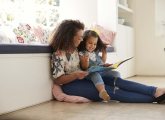Gill Coulson and Lynn Cousins suggest ways to develop children’s reading and writing skills as they play…
Whatever else you may have planned to teach today, your children will be practising their literacy skills all day long. They will be speaking or listening, and maybe reading and writing as part of every activity that they do.
Combining aspects from different parts of the curriculum is recognised as good practice. You might be talking (communication and language) about the size (mathematics) of the giant’s boots as you work together (personal, social and emotional development) to make a model (expressive arts and design).
Combining activities makes sense for you and your planning as it’s an efficient use of your time and resources. More importantly, it helps children make sense of their learning.
Teaching literacy as part of other curriculum areas ensures that the reading and writing skills children are practising will be set in a context, and have importance.
Writing a letter to Father Christmas or replying “Yes, please” to a birthday party invitation brings its own rewards beyond the initial sense of pride in successfully putting words down on paper.
Giving children a purpose for reading and writing helps to build their confidence in themselves as readers and writers.
Making learning as interactive as possible creates a sense of fun and involvement which will carry the children’s interest and enthusiasm in productive ways.
It becomes part of children’s play and as they play, children challenge themselves and attempt more.
- - -
Children’s reading and writing is built on their ability to express themselves verbally. As they retell events from real life or stories, they recall details and sequence key events.
Giving children opportunities for conversations and discussions helps them learn to take turns as they listen and respond to others. It also widens their vocabulary and encourages precision in their use of language.
- - -
Encourage a small group of children to negotiate by giving them a large piece of fabric and some string or pegs. Challenge them to create a shelter outdoors to keep the hot sun off them.
Where will it be? How will they fasten it on? Be ready to help with this. Take notice of the group dynamics as they work. Look out for children with lots of ideas, or those who can persuade others.
Provide a selection of dressing-up clothes and accessories as part of your work on ‘people who help us’. Take it in turns to pose behind an old picture frame and have a photograph taken.
Help the children to form a sentence to describe their photo, “This is Saskia and she is a firefighter.” “My name is Jake and I am a nurse.”
Put a selection of small world toys in a basket and ask three of the children to choose one each. Explain to the group that they’re going to make up a story involving the three chosen objects.
Remind them of familiar story openings. Then take it in turns to make up the story, adding to each other’s ideas as you go along. Will it end ‘happily ever after’?
- - -
Sharing books with young children is a vital, motivating first step on their journey to becoming readers. Creating an attractive book area will encourage children to take an interest.
Help children to respond to labels, names and notices. This introduces the idea that print communicates information. Using nonfiction books to explore a favourite topic or follow a recipe also reinforces this.
Cover a display board in your book area with a bright, spring-like colour. Add some yellow cushions. Display some pictures of ducks and the words of the rhyme Five Little Ducks.
Share a selection of books (fiction and non-fiction) about ducks. Leave these on display and encourage children to find others to add to the collection. Perhaps they would like to bring in a toy duck.
When you have some new books delivered, write their titles onto individual pieces of paper. Pin these up where the children can reach them. Provide stickers in three colours: green, yellow and red.
Explain to the children that they’re going to find out which books are the most popular. Throughout the week children share the books with an adult, either at home or in the nursery.
How much did they enjoy it? Put the sticker of your choice on that book’s paper.
When everyone has had a chance to read and grade the books, count up the stickers and declare the winner.
Make some labels for beds in a hospital and name badges for doctors and nurses. Can children put the dolls into their allocated beds or find their own name badge when they get dressed up to play?
Make a doctor and a nurse badge for each child so that they can choose the role they want to take.
It’s exciting being an author of a book – children love to see their name on the cover. Making books also helps them learn how a book works and provides reading material special to the child.
You don’t have to stick to the traditional format. Try these ideas:
- - -
Young children need fun ways to develop their fine motor skills. They need to strengthen their fingers and make marks before learning to form basic letter shapes.
Don’t forget that children also learn by watching you model the writing process. Opportunities for experimental and freely-produced early writing demonstrate the changes, from random marks and symbols to groups of letters or even words.
This demonstrates children’s developing understanding of letter formation and phonics.
Provide children with a variety of writing tools for writing outside. Before you go outside, remind them to start from the left side. Who knows which side that is?
Supervise this activity closely to encourage good writing habits and children’s safety.
Help children make welcome letters for new children joining your setting. Create the letter together on the computer, leaving spaces for names.
Print out the letters, one for each new child. Help children select the name of one of the new children for writing on the top of the letter.
Alternatively, encourage individual children to write their name at the end. Decide what’s most suitable for your children’s abilities.
Write name labels with children and use them to create a seating plan for a wedding. Explain that the happy couple plan where their guests will sit for the celebration meal.
Collect together all the name cards, then encourage children to choose two of them to be the happy couple. Select a good place for them to sit.
Take turns to set out the rest of the name cards around the tables. Now help the children to find their own name and sit in their place.
More able children can use a simple, drawn seating plan to position the name cards on the table.
- - -
As you do your planning, collect together storybooks, non-fiction books, poems, songs and music that will support your chosen theme of work. Take every opportunity to enjoy these books together.
Have a similar collection for the activities that occur most days: put a basket of train-related books near the train set or the words of ‘Little Bo-Peep’ near the farm set.
Make a playlist of dance music to play alongside a collection of long skirts and fabulous scarves and jewels for those children who prefer to communicate through movement.
Use these throughout the day so that the children have the chance to see the place and importance of literacy and communication in their everyday life.
The activities in this article are based on those found in Gill Coulson and Lynn Cousins’ Games, ideas and activities for Early Years Literacy.

Exploring the World in Montessori Early Years Settings
Editors picks

Early years literacy – Sharing ideas with parents
Editors picks
